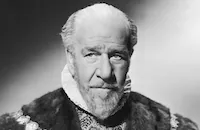Outcast Lady

Brief Synopsis
Cast & Crew
Robert Z. Leonard
Constance Bennett
Herbert Marshall
Mrs. Patrick Campbell
Hugh Williams
Elizabeth Allen
Film Details
Technical Specs

Synopsis
Although they love each other very much, Iris March and her childhood sweetheart, Napier Harpenden, face the intense disapproval of Napier's father, Sir Maurice, who views the relatively poor Iris and her alcoholic brother Gerald as a hindrance to his son's political future. As a compromise, Napier suggests that they wait to marry until he has established himself in the British diplomatic service in India, and Iris reluctantly agrees. After four years of waiting, however, Iris gives in to the pressure of Gerald and accepts the proposal of Boy Fenwick, a much-admired, more prosperous friend of her brother who has loved her quietly for a long time. When Napier receives word of Iris' engagement, he graciously leaves India to attend her wedding in England. Just before the ceremony, a strange woman hands Iris a folded note, which Iris pockets without reading. Then on the first night of her French honeymoon, Iris remembers the note and starts to read it in front of Boy. Disturbed by the note, Iris tries to throw it away, but Boy insists on reading it himself. When Iris gently asks if the note, which claims that, under an assumed name, Boy committed and served prison time for a heinous crime, is true, Boy responds affirmatively. Although Iris bravely dismisses the confession, Boy is overcome with shame and jumps out of the hotel window to his death. A passerby, Dr. Masters, and Hilary, a family friend, learn Boy's secret but, because Iris refuses to reveal the reason for Boy's suicide to anyone else, she is suspected both of pushing him out of the window and of causing his death by callous feminine behavior. In spite of their love for her, even Napier and Gerald, who worshipped Boy, suspect Iris of treachery and turn their backs on her. Thus condemned by family and friends, Iris moves to France and establishes herself as Europe's most notorious widow. Five years later, Iris is notified by Hilary that Gerald is seriously ill and living in squalor and immediately returns to England to see him. After seeing Napier and hearing of his engagement to the respectable Venice, Iris goes to her brother's tenement. Still angry at his sister, the tubercular, drunken Gerald refuses to see her, and fearing that he will die without forgiving her, Iris agrees to allow Hilary to tell him the truth about Boy. Before Hilary reveals Boy's past, Gerald declares his love for Iris and dies without learning the secret. Although relieved by Gerald's forgiveness, Iris returns to France and lapses into a feverish, deluded state. When he learns of Iris' illness, the now married Napier, who has just distinguished himself as a Parliamentary leader, rushes to be with her. When Venice sees Iris and Napier together, she understands the depth of their love but, because of Iris' unexplained past, worries that her husband will one day be hurt by her rival. Unable to keep Boy's secret any longer, Hilary finally tells Napier and Venice the truth, and Venice magnanimously agrees to a divorce. Buoyed by the thought that Napier has forgiven her without knowing Boy's secret, Iris recovers and prepares to face Sir Maurice. Although Sir Maurice backs down from his condemnation of Iris when Napier finally tells him about Boy, Iris is unable go through with the divorce plan and commits suicide by deliberately crashing her automobile.

Director

Robert Z. Leonard
Cast

Constance Bennett

Herbert Marshall
Mrs. Patrick Campbell

Hugh Williams

Elizabeth Allen

Henry Stephenson
Robert Loraine
Lumsden Hare

Leo Carroll

Ralph Forbes

Alec B. Francis
Crew
Adrian
Zoë Akins
Charles Dorian
Cedric Gibbons
Monckton Hoffe
Robert Z. Leonard
William Levanway
Charles Rosher
Douglas Shearer
Herbert Stothart
Irving G. Thalberg
Edwin B. Willis
Art Wilson
Joseph Wright

Film Details
Technical Specs

Articles
Outcast Lady
By Frank Miller

Outcast Lady
Quotes
Trivia
Notes
Author Michael Arlen wrote a stage play called The Green Hat, which was based on his novel and opened in Chicago and Detroit in 1924, and in London on September 2, 1925. The play is not listed in sources as a basis for the film, however. The working titles for this film were The Green Hat and Iris March. Daily Variety, Hollywood Reporter and Motion Picture Daily reviewed the film under the latter title. A November 1934 British supplement of Hollywood Reporter claims that the title was changed from The Green Hat to A Woman of the World as a result of a vote conducted during a public screening of the film. It is not known if the film was ever distributed as A Woman of the World. According to the Preston Sturges Papers at the UCLA Theater Arts Library, Irving G. Thalberg assigned Sturges to write a draft of the script for the picture in September 1933, but his contribution to the final film has not been confirmed. According to a January 1934 Hollywood Reporter news item, Dudley Murphy was first slated to direct Norma Shearer in the film. M-G-M borrowed Hugh Williams from Fox for the production. Hollywood Reporter news items add Reginald Owen and Forrester Harvey to the cast, but their participation in the final film has not been confirmed. After the PCA ordered scenes in the film to be reshot, Monckton Hoffe was assigned to rewrite the objectionable sections, according to a June 1934 Hollywood Reporter news item. Arlen's novel was first filmed by M-G-M as A Woman of Affairs in 1928. Clarence Brown directed Greta Garbo and John Gilbert in this part-sound, part-silent version (see AFI Catalog of Feature Films, 1921-30; F2.6483).














